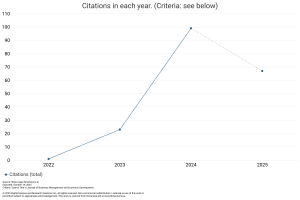Effect of Microfinance Practices on Growth of the Bodaboda Industry in Kenya; A Case of Kamukunji Sub-County
DOI:
https://doi.org/10.59653/jbmed.v1i03.295Keywords:
Microfinance, Boda Boda, Loaning, Saving, Training, Kamukunji Sub-County, KenyaAbstract
This research project aimed to analyze the effect caused by microfinance practices on the growth of the Boda Boda industry in Kenya (a case of the Kamukunji sub-county). A sample size of 150 out of 750 Boda boda riders of the target population in the Kamukunji sub-County, served as the basis for this study. The researcher used a descriptive study design with both qualitative and quantitative research methods being used. Questionnaires were used in data collection. The data was analyzed using statistical techniques such as regression analysis and descriptive statistics. Data was presented using bar graphs, pie charts, and tables to aid in effectively analyzing the results using SPSS software at 95% confidence level. Data was analyzed using tables and simple percentages for easy statistical inference; the hypothesis was tested using multivariate regression analysis. Findings from the study revealed that the interaction between loan accessibility, motorcycle ownership, microfinance training, and savings has surfaced as pivotal elements intricately interwoven into the fabric of industry expansion and empowerment specifically multiple regression results indicated that 91.9 percent of changes in growth are predicted by microfinance practices variables under study giving and the remaining percentage goes by other factors that are not in this study. Some of the recommendations drawn from the study are to enhance training initiatives, champion financial inclusion, foster motorcycle ownership and embrace microfinance education.
Downloads
References
Abera, N., & Asfaw, M. (2019). (A Review on the Effects of Microfinance on Poverty among Rural Households in Ethiopia) published in the Journal of Ecology & Natural Resources, volume 3, issue 5, pages 2578-4994.
Addae-Korankye, A. (2014). (Causes of poverty in Africa): A review of the literature. American International Journal of Social Science, 3(7), 147–153.
Agostino, M. (2008). (Effects of screening and monitoring on credit rationing of SMEs). Economic notes. 37(2-2008), 155-179. Banca Monte dei Paschi di Siena SpA. Oxford: Blackwell Publishing Ltd. https://doi.org/10.1111/j.1468-0300.2008.00195.x
Akter, A., Hossain, M. I., Reaz, A. M. K. M., Shahabuddin, M., Chowdhury, M. T. I., & Akter, F. (2020).(The Role of Micro-Credit on Empowerment of Women in Bangladesh). International Journal of Advanced Science and Technology, 29(2), 3568-3589.
Alesina, A., Giuliano, P., & Nunn, N. (2013). (On the origins of gender roles: Women and the plow). The quarterly journal of Economics, 128(2), 469-530. https://doi.org/10.1093/qje/qjt005
Ali, A. E. E. S. (2017). (The challenges facing poverty alleviation and financial inclusion in North-East Kenya Province (NEKP)). International Journal of Social Economics, 44(12), 2208–2223. https://doi.org/10.1108/IJSE-05-2016-0133
Ali, A. H., Abu-Hadi, A. O., & Ali, A. Y. S. (2013). (The accessibility of microfinance for small businesses in Mogadishu, Somalia). International Journal of Humanities and Social Science, 3(11), 172-180.
Beck, T., Demirguc-Kunt, A., & Peria, M. S. M. (2007). Reaching out: Access to and use of banking services across countries. Journal of financial economics, 85(1), 234-266. https://doi.org/10.1016/j.jfineco.2006.07.002
Black, L., Correa, R., Huang, X., & Zhou, H. (2016). The systemic risk of European banks during the financial and sovereign debt crises. Journal of Banking & Finance, pp. 63, 107–125. https://doi.org/10.1016/j.jbankfin.2015.09.007
Central Bank of Mozambique. (2013). Annual Report, the Bank of Mozambique.
Chakrabarty, K. C. (2011). Financial inclusion. Presentation at St. Xavier's College, Mumbai, on September 7, 2011.
Duwal, S. (2013). Modeling urban growth in Kathmandu Valley (Master's thesis, University of Twente).
Fonteyne, J. P. L. (2017). The Customary International Law Doctrine of Humanitarian Intervention: Its Current Validity under the UN Charter. In The Use of Force in International Law (pp. 477-544). Routledge. https://doi.org/10.4324/9781315084992-19
Gupta, S., & Dhingra, S. (2022). Past, present and future of mobile financial services: A critique, review, and future agenda. International Journal of Consumer Studies. https://doi.org/10.1111/ijcs.12855
Hala, H. E. H. (2018). Impact of Microfinance on Entrepreneurial Development: The Case of Egypt. International Journal of Business and Social Science, 9 (90), 68- 76. https://doi.org/10.30845/ijbss.v9n9p7
Hassanain, K. M. (2015). Integrating Zakah, Awqaf, and IMF for poverty alleviation: Three models of Islamıc microfinance. Journal of Economic and Social Thought, 2(3), 193-211.
John McCumber, “The Failure of Rational Choice Philosophy,” The New York Times Opinion Pages Opinionator (blog), June 19, 2011.
Jones, L. (2018). Guest editorial: Poverty reduction in the FinTech age. Enterprise Development & Microfinance, 29(2), 99–102. https://doi.org/10.3362/1755-1986.2018.29-2.ED
Kamau, A. T. (2010). Assessment of strategies microfinance institutions adapt to survive and grow in the banking industry. A survey of selected MFIs in Kenya. Unpublished Thesis Submitted to Kenyatta University.
Ledgerwood, J., Earne, J., & Nelson, C. (Eds.). (2013). The new microfinance handbook: A financial market system perspective. World Bank Publications. https://doi.org/10.1596/978-0-8213-8927-0
Limbu, D. S. (2014). Role Of Micro-Finance In Poverty Reduction And Women Empowerment (Doctoral dissertation, Central Department of Economics Faculty of Humanities and Social Sciences Tribhuvan University, Kirtipur, Kathmandu).
Makhani, W. (2015). Motorcycle public transport services in Kenya; a study of their compliance with road safety regulations in Kitale Municipality. Master’s project, Nairobi University.
Nshimirimana, E., Githui, T., & Muhavani, A. (2021). Effect of Credit Financing on Financial Performance of Small and Medium Enterprises in Nairobi Central Business District, Kenya. Journal of Finance and Accounting, 5(2) pp. 18-42. https://doi.org/10.53819/81018102t4004
Nyagah, C. N. (2013). Non-financial constraints hindering the growth of SME in Kenya: the case of plastic manufacturing companies in the industrial area in Nairobi County. MBA Project.
Ojo, O. (2009). Impact assessment of corporate culture on employee job performance. Business Intelligence Journal, 2(2), 388–397.
Peter, T., & Cathy, I. M. (2015). Networking for SMEs in Uganda: A conceptual paper. African Journal of Business Management, 9(2), 43–49. https://doi.org/10.5897/AJBM2014.7534
Ramcharran, H. (2017). "Financing Small and Medium-Sized Enterprises in Thailand: The Importance of Bank Loans and Financing Diversification," The Journal of Entrepreneurial. https://doi.org/10.57229/2373-1761.1311
Toroitich, K. K., Jelaga, J. M., & Omwono, G. A. (2016). Factors Affecting Individuals to Adopt Mobile Banking In Kenya: A Case of Kenya Commercial Bank (KCB), Eldoret. International Journal of Research, 3(4), 29-48.
Von Weltzien Høivik, H., & Shankar, D. (2011). How can SMEs in a cluster respond to global demands for corporate responsibility? Journal of Business Ethics, 101(2), 175-195. https://doi.org/10.1007/s10551-010-0708-6
Wambugu, F., W., & Ngugi, J. K. (2012). Factors Influencing Sustainability of Microfinance Institutions in Kenya: A Case of Kenya Women Finance Trust. International Journal of Innovative Research & Development, 1(11), 519 -537.
Zhao, L., Tian, L., Cai, T., Claggett, B., & Wei, L. J. (2013). Effectively selecting a target population for a future comparative study. Journal of the American Statistical Association, 108(502), 527-539. https://doi.org/10.1080/01621459.2013.770705
Downloads
Published
How to Cite
Issue
Section
License
Copyright (c) 2023 Joseph Mwangi Njuguna, Gilbert Nyaga Njagi

This work is licensed under a Creative Commons Attribution-ShareAlike 4.0 International License.
Authors who publish with this journal agree to the following terms:
- Authors retain copyright and grant the journal right of first publication with the work simultaneously licensed under a Creative Commons Attribution-ShareAlike that allows others to share the work with an acknowledgement of the work's authorship and initial publication in this journal.
- Authors are able to enter into separate, additional contractual arrangements for the non-exclusive distribution of the journal's published version of the work (e.g., post it to an institutional repository or publish it in a book), with an acknowledgement of its initial publication in this journal.
- Authors are permitted and encouraged to post their work online (e.g., in institutional repositories or on their website) prior to and during the submission process, as it can lead to productive exchanges, as well as earlier and greater citation of published work (See The Effect of Open Access).





























